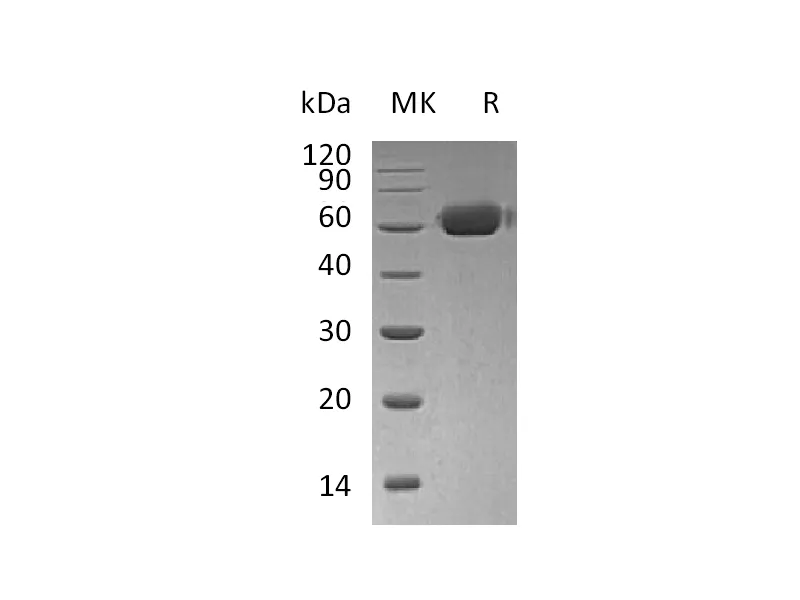
Size2:50μg price2:$465
Size3:500μg price3:$2325
| Name | Recombinant Human OPG (C-Fc) |
| Purity | Greater than 95% as determined by reducing SDS-PAGE |
| Endotoxin level | <1 EU/µg as determined by LAL test. |
| Construction | Recombinant Human Osteoprotegerin is produced by our Mammalian expression system and the target gene encoding Glu22-Leu201 is expressed with a human IgG1 Fc tag at the C-terminus. |
| Accession # | O00300 |
| Host | Human Cells |
| Species | Human |
| Predicted Molecular Mass | 47.2 KDa |
| Buffer | Lyophilized from a 0.2 μm filtered solution of PBS, pH 7.4. |
| Form | Lyophilized |
| Shipping | The product is shipped at ambient temperature.Upon receipt, store it immediately at the temperature listed below. |
| Stability&Storage | Lyophilized protein should be stored at ≤ -20°C, stable for one year after receipt. Reconstituted protein solution can be stored at 2-8°C for 2-7 days. Aliquots of reconstituted samples are stable at ≤ -20°C for 3 months. |
| Reconstitution | Always centrifuge tubes before opening.Do not mix by vortex or pipetting.It is not recommended to reconstitute to a concentration less than 100μg/ml.Dissolve the lyophilized protein in distilled water.Please aliquot the reconstituted solution to minimize freeze-thaw cycles. |
Alternative Names
Tumor necrosis factor receptor superfamily member 11B; Osteoclastogenesis inhibitory factor; Osteoprotegerin; TNFRSF11B; OCIF; OPG
Background
TNFRSF11B is a secreted protein, containing 2 death domains and 4 TNFR-Cys repeats. TNFRSF11B is a decoy receptor for the receptor activator of nuclear factor kappa B ligand (RANKL). By binding RANKL, TNFRSF11B inhibits nuclear kappa B (NF-κB) which is a central and rapid acting transcription factor for immune-related genes, and a key regulator of inflammation, innate immunity, and cell survival and differentiation. TNFRSF11B levels are influenced by voltage-dependent calcium channelsCav1.2. TNFRSF11B can reduce the production of osteoclasts by inhibiting the differentiation of osteoclast precursors into osteoclasts and also regulates the resorption of osteoclasts in vitroand in vivo. TNFRSF11B binding to RANKL on osteoblast/stromal cells, blocks the RANKL-RANK ligand interaction between osteoblast/stromal cells and osteoclast precursors. This has the effect of inhibiting the differentiation of the osteoclast precursor into a mature osteoclast.
Note
For Research Use Only , Not for Diagnostic Use.
